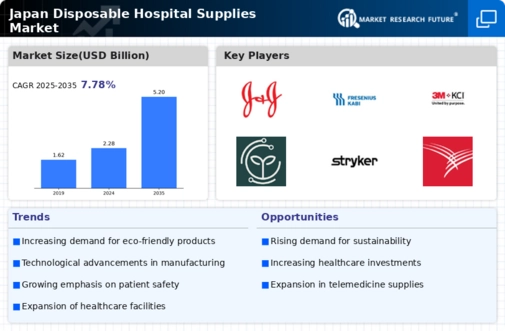Rising Healthcare Expenditure
The increasing healthcare expenditure in Japan is a pivotal driver for the disposable hospital supplies market. As the government allocates more funds to healthcare, hospitals are likely to invest in high-quality disposable supplies to enhance patient care. In 2025, healthcare spending in Japan is projected to reach approximately $500 billion, reflecting a growth rate of around 3% annually. This trend indicates a robust demand for disposable products, as hospitals seek to maintain hygiene and efficiency. Furthermore, the aging population in Japan necessitates more medical interventions, further propelling the need for disposable hospital supplies. The disposable hospital-supplies market is thus positioned to benefit from this upward trajectory in healthcare investment, as facilities prioritize patient safety and operational efficiency.
Increased Focus on Infection Control
The heightened focus on infection control measures in healthcare facilities is a crucial driver for the disposable hospital-supplies market. In Japan, hospitals are increasingly adopting stringent protocols to prevent hospital-acquired infections (HAIs). This trend is supported by data indicating that HAIs affect approximately 5% of hospitalized patients, leading to significant healthcare costs. As a result, the demand for disposable supplies, such as gloves, masks, and gowns, is on the rise. The disposable hospital-supplies market is expected to grow as healthcare providers prioritize infection prevention strategies, thereby ensuring patient safety and compliance with health regulations. This focus on infection control is likely to sustain market growth in the coming years.
Technological Integration in Healthcare
The integration of advanced technologies in healthcare settings is significantly influencing the disposable hospital-supplies market. Innovations such as automated supply management systems and smart inventory tracking are becoming commonplace in hospitals across Japan. These technologies enhance the efficiency of supply usage, reduce waste, and ensure that essential disposable items are always available. The market for smart healthcare technologies is expected to grow at a CAGR of 5% through 2027, indicating a strong correlation with the demand for disposable supplies. As hospitals adopt these technologies, the disposable hospital-supplies market is likely to experience increased demand, driven by the need for seamless operations and improved patient outcomes.
Growing Demand for Home Healthcare Solutions
The shift towards home healthcare solutions is emerging as a significant driver for the disposable hospital-supplies market. With an increasing number of patients receiving care at home, there is a rising need for disposable medical supplies that facilitate safe and effective treatment outside traditional hospital settings. In Japan, the home healthcare market is projected to grow by 4% annually, reflecting a broader trend towards patient-centered care. This shift necessitates a reliable supply of disposable products, such as syringes, wound care items, and diagnostic tools, to support at-home treatment. Consequently, the disposable hospital-supplies market is likely to expand as manufacturers adapt to meet the needs of this evolving healthcare landscape.
Aging Population and Chronic Disease Management
Japan's aging population is a critical driver for the disposable hospital-supplies market. As the demographic shifts towards an older population, the prevalence of chronic diseases is expected to rise, necessitating increased medical interventions. By 2025, it is estimated that over 30% of the population will be aged 65 and older, leading to a higher demand for disposable medical supplies used in chronic disease management. This demographic trend suggests a sustained growth trajectory for the disposable hospital-supplies market, as healthcare providers seek to ensure adequate supply levels for managing various health conditions. The focus on chronic disease management will likely drive innovation and expansion within the market.




















Leave a Comment